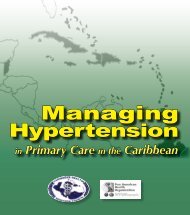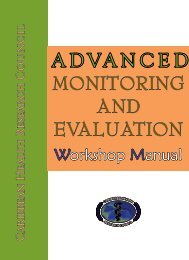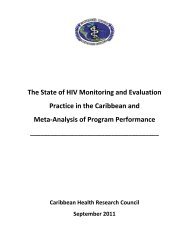Download Basic M&E Facilitator's Guide - CHRC
Download Basic M&E Facilitator's Guide - CHRC
Download Basic M&E Facilitator's Guide - CHRC
- No tags were found...
Create successful ePaper yourself
Turn your PDF publications into a flip-book with our unique Google optimized e-Paper software.
BASICMONITORINGANDEVALUATIONWORKSHOPFacilitator <strong>Guide</strong>© 2011
DisclaimerThis publication was supported by the Cooperative AgreementNumber 5U2GPS001914 from The Centers for Disease Control andprevention. Its contents are solely the responsibility of the CaribbeanHealth Research Council and do not necessarily represent theofficial views of the Centers for Disease Control and Prevention.The material contained herein is that of a collaboration betweenthe Caribbean Health Research Council (<strong>CHRC</strong>), the U.S. Centersfor Disease Control and Prevention and the Regional Monitoringand Evaluation Technical Working Group. Please seek permissionfrom the <strong>CHRC</strong> to copy, modify, publish or transmit this materialwhich was compiled specifically for the purposes of this workshop.Page iv
Table of ContentsAcknowledgements ......................................................................................................viiPreface ...................................................................................................................... ixPresentation 1: Introduction to Monitoring and Evaluation .........................................................11Presentation 2: Understanding &Describing your Programme......................................................21Presentation 3: The Logic Model ........................................................................................ 29Presentation 4: Monitoring and Evaluation Indicators ................................................................33Presentation 5: Data Collection Methods for Monitoring and Evaluation...........................................37Presentation 6: Data Flow ............................................................................................... 43Presentation 8: Introduction to Quantitative and Qualitative Data Analysis........................................47Presentation 9: Dissemination of M&E Findings ......................................................................53Presentation 10: Developing Monitoring and Evaluation Plans .....................................................57Page v
Page vi
AcknowledgementsThe <strong>Basic</strong> Monitoring and Evaluation (M&E) Workshop Manual and Facilitator <strong>Guide</strong> arethe culmination of a collective effort by a number of agencies, coordinated and led by theCaribbean Health Research Council (<strong>CHRC</strong>).<strong>CHRC</strong> expresses gratitude to the principal collaborators i.e. the members of the Caribbean M&ETechnical Working Group. The latter comprised the Caribbean HIV Alliance, Caribbean HIVAIDS Regional Training Network (CHART), US Centers for Disease Control and Prevention(CDC), PAHO HIV Caribbean Office, UNAIDS, and HIV Programme Unit of the Organizationof Eastern Caribbean States (OECS).<strong>CHRC</strong> acknowledges the critical role of the scores of Caribbean health professionals fromMinistries of Health and National AIDS Programmes who participated in M&E workshops andprovided the feedback that guided the development of the current document. <strong>CHRC</strong> is also gratefulto the Pan Caribbean Partnership on HIV/AIDS (PANCAP) for the funding of M&E workshopssince 2003 and the Trinidad and Tobago Health Training Centre (TTHTC), which contributed tothe development of the Manual.It is also important to recognize the hardworking <strong>CHRC</strong> M&E Specialists and Officers for theirrole in leading this initiative, including the finalization of the structure and content of the Manual.The <strong>CHRC</strong> Administrative staff members were also responsible for the formatting and graphicsdesign of the document.The development of this <strong>Basic</strong> M&E Workshop Manual and Facilitator <strong>Guide</strong> would not havebeen possible without the funding received from the CDC, through a Co-operative Agreementwith <strong>CHRC</strong>.Page vii
Page viii
PrefaceMonitoring and Evaluation (M&E) is recognised as an essential management tool andthe <strong>Basic</strong> M&E Training Workshop was designed to build the capacity of professionalsinvolved in health programme planning and implementation as well as those tasked withthe collection and use of data for decision making. Consequently, the aim of the Workshop is toincrease participants’ knowledge and understanding of fundamental monitoring and evaluationprinciples and to enable them to apply these to their work. This is expected to result in greaterefficiency and effectiveness of health programmes.The workshop is structured to ensure that participants are tooled to contribute to their Ministry’s/institution’s M&E functions including the development of M&E plans and the management ofdata. The Workshop Manual and Facilitator <strong>Guide</strong> therefore comprise the following modules:• Introduction to M&E• Understanding and Describing Your Programme• The Logic Model• M&E Indicators• Data Collection Methods for M&E• Data Flow• Data Quality and Data Management• Introduction to Quantitative and Qualitative Data Analysis• Dissemination of M&E Findings• Developing M&E PlansConsistent with the practical approach to the Workshop, each module in the Manual includes anumber of exercises that participants are required to do as group work. These are designed toensure the effective transfer of knowledge through a practical hands-on approach.The Facilitator <strong>Guide</strong> was developed to assist persons conducting the workshops to better facilitatethe group exercises. It includes model answers and is to be used in tandem with the <strong>Basic</strong> M&EWorkshop Manual.Page ix
Page x
Presentation 1: Introduction to Monitoringand EvaluationΏΏActivities 1 - 4ΏΏModel AnswersPage 11
Activity 1Instructions to Facilitator: Invite participants to discuss the followingPage 12
Activity 1Model AnswersExamples of monitoring activities:• Checking that the resource allocation is as intended in the project design• Observing the performance of counsellor-testers at VCT sites• Testing the accuracy of a sample of the data• Identifying where the data flow is impeded in the programme operations• Identifying the reasons for unintended outcomes• Collecting contextual information to guide the revision of programme goals and outcomes• Assessing the progress (at intervals of less than six months) made towards achievingthe targets identified in the programme indicatorsExamples of evaluation activities:• Assessing the achievement of programme goals at the end of the programme• Assessing the progress made towards the achievement of programme indicatorsyearly in a five-year programme• Assessing the impact of a programme on intended recipients• Utilizing the results of a year-one evaluation to revise the programme goals in yeartwo• Utilizing evidence (data) to continue, revise or stop a programme• Assessing why a programme was successful or a failure after its completionPage 13
Activity 2Instruction to Facilitator: Working in groups of 4/5 persons, participants areto complete the table below. 1 group reports to larger group, while the othergroup stick theirs on the walls.Page 14
Page 16
Presentation 2: Understanding &Describingyour ProgrammeΏΏActivity 1 - 4ΏΏWorksheetsΏΏModel AnswersPage 21
Activity 1Instructions to Facilitator: Facilitator informs participants to use theworksheet provided to answer the following questions as they relate to theirprogrammePage 22
Activity 1Model Answers1. What need/s or problem/s does the programme address?• There is an increase in the number of new sexually transmitted diseases (STDs) amongyoung people (15 -18) in the towns of Betang and St. Jasmine. This is a prevention programmedesigned to help young persons make safer sexual choices.2. Who are the intended recipients?• Students (14-18) in the Betang High School and St. Jasmine High School3. What will the recipients receive and then expected to do?• Health care professionals, social workers and youth leaders will join together to deliverthe programme entitled “My choice is Life”. Participants will participate in, and viewshort theatrical skits, view films, listen to lectures, receive counseling, engage in debates,view demonstrations.4. What are the intended outcomes for the recipients, for the programme?• Students will learn about STDs.• Students will learn some strategies to negotiate their intimate relationships.• Less students will test positive for STDs in Betang and St. Jasmine.• Students will engage in safer sexual practices.5. What is the desired impact of the programme?• Less students will be in need of STI testing• No students test positive for HIV/AIDS.• Less students will engage in sex.6. Who are the stakeholders?• Students, parents, family members, teachers, school community, health care professionals,residential communityPage 23
Activity 2Instructions to Facilitator: Ask the participants to do the following and selecta few to share and the group to presentPage 24
Activity 3Instructions to Facilitator: Refer to slides 17-21Page 25
Activity 3Model AnswersExamplesProblem / Need -Intended participants -What need is the programme designed to address?Is the programme attracting the intended recipients?Who are the unintended programme recipients?Intended strategy/ implementation -Were the legal and ethical rights of participants respected?Were there implementation guidelines?Intended outcomes -Were the programme targets achieved?What factors hindered or facilitated the programme’ssuccess?Desired impacts -How do the intended participants view the programme?Did the programme have the desired impact on theintended participants?Page 26
Page 27
Page 28
Presentation 3: The Logic ModelΏΏActivity 1ΏΏModel AnswerPage 29
Page 30
Model AnswerPage 31
Page 32
Presentation 4: Monitoring and EvaluationIndicatorsΏΏActivity 1ΏΏWorksheetPage 33
Page 34
Page 35
Page 36
Presentation 5: Data Collection Methods forMonitoring and EvaluationΏΏActivity 1ΏΏWorksheetΏΏModel AnswersPage 37
Page 38
Activity 1Model AnswersExample 1Indicator:Percent of adults aged 15-49 who have has sexwith more than one partner in the last 12 monthsType of data to be collected:Primary dataMost appropriate method of collection:Quantitative methods should be used as the intention isto measure the % with more than one partner.A survey would be the best method to useOther relevant issues:Who will fund the survey? Who will conduct it? Would itbe a community or institution based study?Example 2Indicator:Percent of donated blood units screened for HIV ina quality-assured mannerType of data to be collected:Secondary dataMost appropriate method of collection:Quantitative methods should be used as the intention isto measure the % of units screened.Record abstraction would be the method to useOther relevant issues:Access and permission to use to the blood donationdatabase. Who will collect the data?Page 39
Example 3Indicator:Reasons for non-use of condoms by commercialsex workersType of data to be collected:Primary dataMost appropriate method of collection:Qualitative methods should be used as the intention isto is to get insights about an observed behavior.Focus group discussions would be an appropriatemethod to useOther relevant issues:Recruitment of the participants of the FGD. Numberand membership of the groups. Who will facilitate thesessions?Page 40
Page 41
Page 42
Presentation 6: Data FlowΏΏActivity 1ΏΏModel AnswerPage 43
Page 44
Model AnswerPage 45
Page 46
Presentation 8: Introduction to Quantitativeand Qualitative Data AnalysisΏΏActivity 1ΏΏModel AnswersPage 47
Page 48
Activity 1Model AnswersIndicator:Percent of adults aged 15-49 who have has sexwith more than one partner in the last 12 monthsType of data analysis:QuantitativeDescriptive:Aggregated:Measurement is categorical (respondent either had ordid not have more than one partner) –so should present the result as a percentagePresentation of the result for the whole populationDisaggregated:May wish to present the results disaggregated bygender i.e. present the % of males and the % of femaleswith more than one partnerCan also disaggregate by age group e.g. can present theresults for persons aged 15-24y, 25-34y and 35-44 yearsComparisonsCan tabulate and compare the % with more than onepartner for the various disaggregated groups i.e.compare males v females; age 15-24 v 25-34 v35-44, etc.Can also compare the % over time to examine anychange in the rate of multiple partnership e.g. cancompare the % in 2000 (year of previous survey)with the % in 2011 (current survey) to determine if therate has changed over that period.Page 49
Example 2Indicator:Reasons for non-use of condoms by commercialsex workersType of data analysis:Qualitative.The various reasons given by the respondents can begrouped – common themes can be identified.Can also perform content analysis by counting recurringwords, themesNotes:Analysis should be systematic and comprehensive.Keep an open mind and be flexible – should notonly look for data to support your theory.Page 50
Page 51
Page 52
Presentation 9: Dissemination of M&EFindingsΏΏActivity 1ΏΏWorksheetPage 53
Page 54
Page 55
Page 56
Presentation 10: Developing Monitoring andEvaluation PlansΏΏActivity 1Page 57
Page 58





